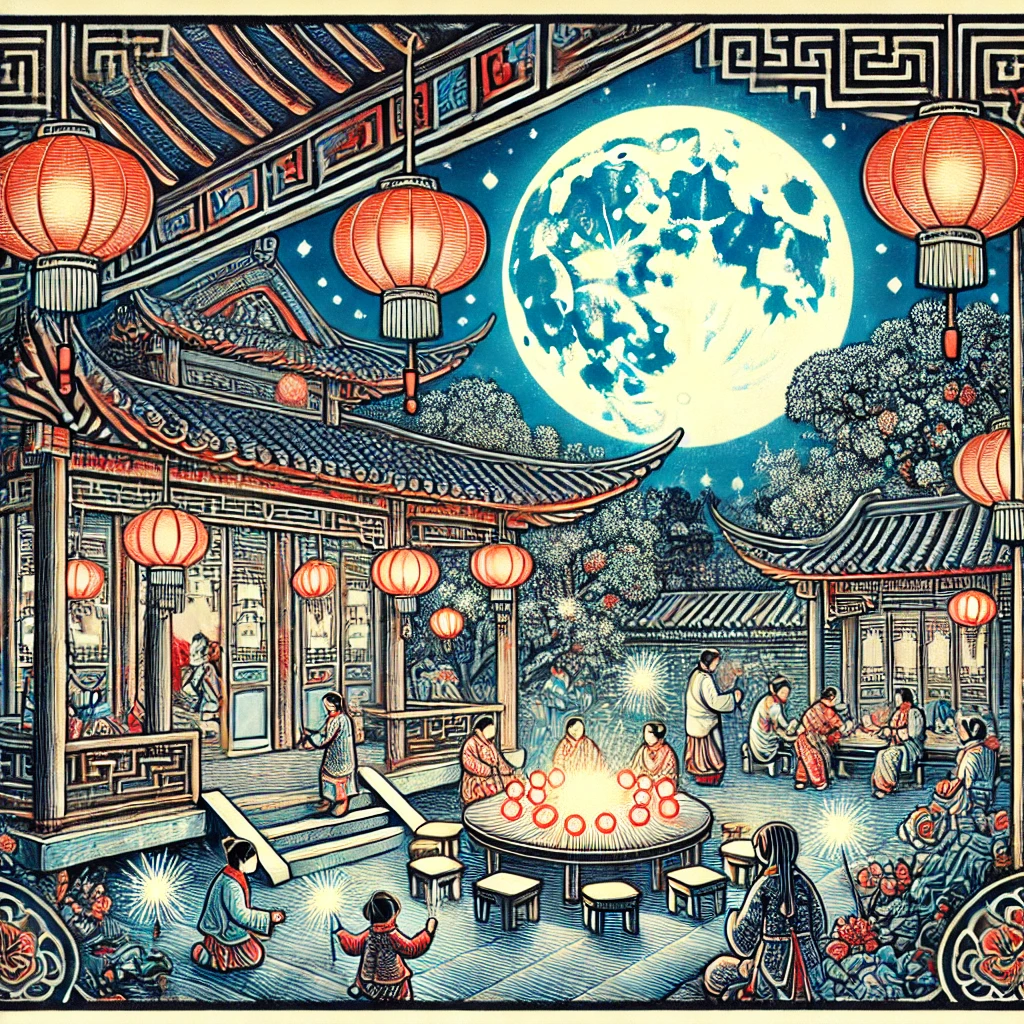The Mid-Autumn Festival, also known as the Moon Festival, is one of the most important and widely celebrated festivals in Chinese culture. Held on the 15th day of the 8th lunar month, this festival marks the end of the autumn harvest and is deeply rooted in the agricultural traditions of rural China. Historically, it was a time for farmers to celebrate the successful gathering of crops and to give thanks to the moon for its role in providing a bountiful harvest. The full moon, symbolizing completeness and unity, is at its brightest and most beautiful during this time, making it a perfect occasion for family reunions and communal celebrations.
Myths and Legends
The Mid-Autumn Festival is rich with mythical tales that add a layer of enchantment to the celebrations. Among these myths, the story of Chang’e, the Moon Goddess, is perhaps the most famous. Other popular legends include the tales of the Jade Rabbit and Wu Gang. These stories, steeped in themes of love, sacrifice, and perseverance, are often shared during family gatherings as part of the festival’s traditions.
Read also:
- Mid-Autumn Moon Festival Children Books | Art Sprouts’s Favourite Pick
- Moonlight Reading: Favorite Children’s Books about the Moon
Celebrating the Mid-Autumn Festival
Several key elements define the Mid-Autumn Festival and its celebrations:
Mooncakes
Mooncakes are the quintessential treat of the Mid-Autumn Festival. These round pastries come in various flavors and fillings, such as sweet red bean paste, lotus seed paste, and salted egg yolks. Each region in China has its unique take on mooncakes, reflecting local tastes and cultural influences. Sharing mooncakes symbolizes family reunion and completeness, mirroring the round shape of the full moon. There is a popular tale that during the Yuan Dynasty (1271-1368 AD), mooncakes were used to hide secret messages that helped coordinate a rebellion against Mongol rule. Although this story is likely a myth and later nationalist propaganda, it has become an enduring part of the festival’s lore.
Family Gatherings
The festival is a time for family reunions, where members come together to enjoy a festive meal and spend quality time with each other. Traditional meals often include dishes that are symbolic of unity and togetherness, and the evening is usually spent appreciating the full moon and sharing stories and mooncakes. This tradition highlights the importance of family in Chinese culture, where multi-generational families often live together or maintain close connections despite physical distances.
Save for later:
Moon Worship and Lanterns
Moon worship is an ancient tradition where families set up altars with offerings of mooncakes, fruits, and other foods to honor the Moon Goddess, Chang’e, and pray for good fortune. This tradition dates back to the Tang Dynasty (618-907 AD) when Emperor Xuanzong would hold grand ceremonies to honor the moon. The Tang Dynasty is considered a golden age of Chinese culture, marked by significant achievements in art, literature, and trade. Lantern displays and lantern-making activities are also popular, with children crafting colorful lanterns that are hung in trees, houses, or floated on rivers, creating a magical, illuminated landscape.
Lesser-Known Traditions and Customs
Beyond the widely recognized customs, several minority ethnic groups and Chinese communities abroad have their unique ways of celebrating the Mid-Autumn Festival:
Mongolians
Mongolians celebrate by “chasing the moon,” where they ride horses across the grasslands, following the moon from rise to set. The Mongolian people are known for their nomadic lifestyle and horsemanship, and this celebration reflects their cultural heritage and connection to the land.
Tibetans
In Tibet, people celebrate by “seeking the moon,” gathering around ponds or rivers to find the moon’s reflection in the water before returning home for reunions and mooncakes.
Zhuang People
The Zhuang people invite a goddess from heaven to join their festivities. The ritual involves setting up a sacrificial table, antiphonal singing, divination, and eventually sending the goddess back to heaven, emphasizing the spiritual and communal aspects of the festival. The Zhuang are the largest ethnic minority in China, primarily residing in the Guangxi Zhuang Autonomous Region.
Dong People
In Hunan Province, the Dong people practice “stealing moon vegetables,” where they believe fairies from the Moon Palace bestow sweet dews on vegetables and fruits. This allows everyone to share in the bounty without being considered thieves, and the tradition holds special significance for young people seeking love and happiness. The Dong are known for their polyphonic choir singing and wooden architecture, reflecting their rich cultural heritage.
Chinese Communities Abroad
Chinese communities worldwide, including those in cities like San Francisco, Vancouver, and Sydney, celebrate the Mid-Autumn Festival with a mix of traditional and local customs. These celebrations often include parades, mooncake fairs, and cultural performances, showcasing the adaptability and fusion of Chinese traditions with local cultures. These communities play a crucial role in preserving and promoting Chinese cultural heritage abroad.
Fire Dragon Dance in Hong Kong
In Hong Kong, one of the most spectacular events is the Fire Dragon Dance. During the Mid-Autumn Festival, a dragon made of straw and incense sticks is paraded through the streets, creating a stunning visual display believed to bring good luck and ward off evil spirits. This tradition highlights Hong Kong’s unique blend of Chinese and colonial influences, making its celebrations particularly vibrant and distinctive
The Mid-Autumn Festival is a wonderful time to celebrate harvest, family, and cultural heritage. Its traditions and myths offer a glimpse into Chinese culture, emphasizing themes like love, sacrifice, and togetherness. Whether you’re in China or celebrating abroad, the festival’s customs, from mooncakes to lantern displays, bring people closer and create lasting memories under the bright full moon.


